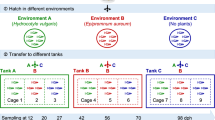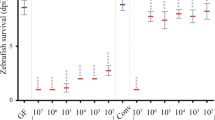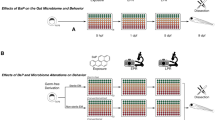Abstract
Experimental analysis of gut microbial communities and their interactions with vertebrate hosts is conducted predominantly in domesticated animals that have been maintained in laboratory facilities for many generations. These animal models are useful for studying coevolved relationships between host and microbiota only if the microbial communities that occur in animals in lab facilities are representative of those that occur in nature. We performed 16S rRNA gene sequence-based comparisons of gut bacterial communities in zebrafish collected recently from their natural habitat and those reared for generations in lab facilities in different geographic locations. Patterns of gut microbiota structure in domesticated zebrafish varied across different lab facilities in correlation with historical connections between those facilities. However, gut microbiota membership in domesticated and recently caught zebrafish was strikingly similar, with a shared core gut microbiota. The zebrafish intestinal habitat therefore selects for specific bacterial taxa despite radical differences in host provenance and domestication status.
Similar content being viewed by others
Log in or create a free account to read this content
Gain free access to this article, as well as selected content from this journal and more on nature.com
or
Accession codes
References
Alexander DA, Orcutt RP, Henry JC, Baker Jr J, Bissahoyo AC, Threadgill DW . (2006). Quantitative PCR assays for mouse enteric flora reveal strain-dependent differences in composition that are influenced by the microenvironment. Mamm Genome 17: 1093–1104.
Bäckhed F, Ley RE, Sonnenburg JL, Peterson DA, Gordon JI . (2005). Host-bacterial mutualism in the human intestine. Science 307: 1915–1920.
Bates JM, Akerlund J, Mittge E, Guillemin K . (2007). Intestinal alkaline phosphatase detoxifies lipopolysaccharide and prevents inflammation in zebrafish in response to the gut microbiota. Cell Host Microbe 2: 371–382.
Bates JM, Mittge E, Kuhlman J, Baden KN, Cheesman SE, Guillemin K . (2006). Distinct signals from the microbiota promote different aspects of zebrafish gut differentiation. Dev Biol 297: 374–386.
Brugman S, Liu KY, Lindenbergh-Kortleve D, Samsom JN, Furuta GT, Renshaw SA et al. (2009). Oxazolone-induced enterocolitis in zebrafish depends on the composition of the intestinal microbiota. Gastroenterology 137: 1757–1767.
Camp JG, Kanther M, Semova I, Rawls JF . (2009). Patterns and scales in gastrointestinal microbial ecology. Gastroenterology 136: 1989–2002.
Caporaso JG, Kuczynski J, Stombaugh J, Bittinger K, Bushman FD, Costello EK et al. (2010). QIIME allows analysis of high-throughput community sequencing data. Nat Methods 7: 335–336.
Cheesman SE, Guillemin K . (2007). We know you are in there: conversing with the indigenous gut microbiota. Res Microbiol 158: 2–9.
Cheesman SE, Neal JT, Mittge E, Seredick BM, Guillemin K . (2011). Microbes and Health Sackler Colloquium: Epithelial cell proliferation in the developing zebrafish intestine is regulated by the Wnt pathway and microbial signaling via Myd88. Proc Natl Acad Sci USA 108(Suppl 1): 4570–4577.
Cox CR, Gilmore MS . (2007). Native microbial colonization of Drosophila melanogaster and its use as a model of Enterococcus faecalis pathogenesis. Infect Immun 75: 1565–1576.
DeSantis Jr TZ, Hugenholtz P, Keller K, Brodie EL, Larsen N, Piceno YM et al. (2006). NAST: a multiple sequence alignment server for comparative analysis of 16S rRNA genes. Nucleic Acids Res 34: W394–W399.
Dewhirst FE, Chien CC, Paster BJ, Ericson RL, Orcutt RP, Schauer DB et al. (1999). Phylogeny of the defined murine microbiota: altered Schaedler flora. Appl Environ Microbiol 65: 3287–3292.
Eisen MB, Spellman PT, Brown PO, Botstein D . (1998). Cluster analysis and display of genome-wide expression patterns. Proc Natl Acad Sci USA 95: 14863–14868.
Engeszer RE, Patterson LB, Rao AA, Parichy DM . (2007). Zebrafish in the wild: a review of natural history and new notes from the field. Zebrafish 4: 21–40.
Engeszer RE, Wang G, Ryan MJ, Parichy DM . (2008). Sex-specific perceptual spaces for a vertebrate basal social aggregative behavior. Proc Natl Acad Sci USA 105: 929–933.
Finegold SM, Vaisanen ML, Molitoris DR, Tomzynski TJ, Song Y, Liu C et al. (2003). Cetobacterium somerae sp. nov. from human feces and emended description of the genus Cetobacterium. Syst Appl Microbiol 26: 177–181.
Frank DN . (2008). XplorSeq: a software environment for integrated management and phylogenetic analysis of metagenomic sequence data. BMC Bioinformatics 9: 420.
Fraune S, Bosch TC . (2007). Long-term maintenance of species-specific bacterial microbiota in the basal metazoan Hydra. Proc Natl Acad Sci USA 104: 13146–13151.
Friswell MK, Gika H, Stratford IJ, Theodoridis G, Telfer B, Wilson ID et al. (2010). Site and strain-specific variation in gut microbiota profiles and metabolism in experimental mice. PLoS One 5: e8584.
Grunwald DJ, Eisen JS . (2002). Headwaters of the zebrafish-emergence of a new model vertebrate. Nat Rev Genet 3: 717–724.
Guryev V, Koudijs MJ, Berezikov E, Johnson SL, Plasterk RH, van Eeden FJ et al. (2006). Genetic variation in the zebrafish. Genome Res 16: 491–497.
Hamady M, Lozupone C, Knight R . (2010). Fast UniFrac: facilitating high-throughput phylogenetic analyses of microbial communities including analysis of pyrosequencing and PhyloChip data. ISME J 4: 17–27.
Huber I, Spanggaard B, Appel KF, Rossen L, Nielsen T, Gram L . (2004). Phylogenetic analysis and in situ identification of the intestinal microbial community of rainbow trout (Oncorhynchus mykiss, Walbaum). J Appl Microbiol 96: 117–132.
Huse SM, Welch DM, Morrison HG, Sogin ML . (2010). Ironing out the wrinkles in the rare biosphere through improved OTU clustering. Environ Microbiol 12: 1889–1898.
Ivanov II, Atarashi K, Manel N, Brodie EL, Shima T, Karaoz U et al. (2009). Induction of intestinal Th17 cells by segmented filamentous bacteria. Cell 139: 485–498.
Kanther M, Rawls JF . (2010). Host-microbe interactions in the developing zebrafish. Curr Opin Immunol 22: 10–19.
Kim DH, Brunt J, Austin B . (2007). Microbial diversity of intestinal contents and mucus in rainbow trout (Oncorhynchus mykiss). J Appl Microbiol 102: 1654–1664.
Kumar Y, Westram R, Kipfer P, Meier H, Ludwig W . (2006). Evaluation of sequence alignments and oligonucleotide probes with respect to three-dimensional structure of ribosomal RNA using ARB software package. BMC Bioinformatics 7: 240.
Lane DJ . (1991). 16S/23S rRNA sequencing. In: Stackebrandt E (ed), Nucleic Acid Techniques in Bacterial Systematics. John Wiley & Sons: New York, pp 115–175.
Lawrence C . (2007). The husbandry of zebrafish (Danio rerio): a review. Aquaculture 269: 1–20.
Ley RE, Hamady M, Lozupone C, Turnbaugh PJ, Ramey RR, Bircher JS et al. (2008). Evolution of mammals and their gut microbes. Science 320: 1647–1651.
Lozupone C, Lladser ME, Knights D, Stombaugh J, Knight R . (2010). UniFrac: an effective distance metric for microbial community comparison. ISME J 5: 169–172.
Maddison D, Maddison W . (2000). MacClade 4: analysis phylogeny and character evolution. Sinauer Associates: Sunderland, MA, USA.
Merrifield DL, Burnard D, Bradley G, Davies SJ, Baker RTM . (2009). Microbial community diversity associated with the intestinal mucosa of farmed rainbow trout (Oncoryhnchus mykiss Walbaum). Aquacult Res 40: 1064–1072.
Navarrete P, Espejo RT, Romero J . (2009). Molecular analysis of microbiota along the digestive tract of juvenile Atlantic salmon (Salmo salar L). Microb Ecol 57: 550–561.
Navarrete P, Magne F, Mardones P, Riveros M, Opazo R, Suau A et al. (2010). Molecular analysis of intestinal microbiota of rainbow trout (Oncorhynchus mykiss). FEMS Microbiol Ecol 71: 148–156.
Peterson J, Garges S, Giovanni M, McInnes P, Wang L, Schloss JA et al. (2009). The NIH Human Microbiome Project. Genome Res 19: 2317–2323.
Petrie-Hanson L, Romano CL, Mackey RB, Khosravi P, Hohn CM, Boyle CR . (2007). Evaluation of zebrafish Danio rerio as a model for Enteric Septicemia of Catfish (ESC). J Aquat Animal Health 19: 151–158.
Plumb JA . (1999). Edwardsiella septicaemias. In: Woo PTK, Bruno DW (eds), Fish Diseases and Disorders: Viral, Bacterial, and Fungal Infections. CAB International: Wallingford, UK, pp 479–521.
Pressley ME, Phelan III PE, Witten PE, Mellon MT, Kim CH . (2005). Pathogenesis and inflammatory response to Edwardsiella tarda infection in the zebrafish. Dev Comp Immunol 29: 501–513.
Qin J, Li R, Raes J, Arumugam M, Burgdorf KS, Manichanh C et al. (2010). A human gut microbial gene catalogue established by metagenomic sequencing. Nature 464: 59–65.
Rawls JF, Frieda MR, McAdow AR, Gross JP, Clayton CM, Heyen CK et al. (2003). Coupled mutagenesis screens and genetic mapping in zebrafish. Genetics 163: 997–1009.
Rawls JF, Mahowald MA, Ley RE, Gordon JI . (2006). Reciprocal gut microbiota transplants from zebrafish and mice to germ-free recipients reveal host habitat selection. Cell 127: 423–433.
Rawls JF, Samuel BS, Gordon JI . (2004). Gnotobiotic zebrafish reveal evolutionarily conserved responses to the gut microbiota. Proc Natl Acad Sci USA 101: 4596–4601.
Romero J, Navarrete P . (2006). 16S rDNA-based analysis of dominant bacterial populations associated with early life stages of coho salmon (Oncorhynchus kisutch). Microb Ecol 51: 422–430.
Saldanha AJ . (2004). Java Treeview - extensible visualization of microarray data. Bioinformatics 20: 3246–3248.
Schloss PD, Westcott SL, Ryabin T, Hall JR, Hartmann M, Hollister EB et al. (2009). Introducing mothur: open-source, platform-independent, community-supported software for describing and comparing microbial communities. Appl Environ Microbiol 75: 7537–7541.
Scupham AJ, Patton TG, Bent E, Bayles DO . (2008). Comparison of the cecal microbiota of domestic and wild turkeys. Microb Ecol 56: 322–331.
Shiina A, Itoi S, Washio S, Sugita H . (2006). Molecular identification of intestinal microflora in Takifugu niphobles. Comp Biochem Phys D 1: 128–132.
Smriga S, Sandin SA, Azam F . (2010). Abundance, diversity, and activity of microbial assemblages associated with coral reef fish guts and feces. FEMS Microbiol Ecol 73: 31–42.
Stamatakis A, Hoover P, Rougemont J . (2008). A rapid bootstrap algorithm for the RAxML web servers. Syst Biol 57: 758–771.
Sugita H, Miyajima C, Deguchi Y . (1991). The vitamin B12-producing ability of the intestinal microflora of freshwater fish. Aquaculture 92: 267–276.
Tsuchiya C, Sakata T, Sugita H . (2008). Novel ecological niche of Cetobacterium somerae, an anaerobic bacterium in the intestinal tracts of freshwater fish. Lett Appl Microbiol 46: 43–48.
Turnbaugh PJ, Hamady M, Yatsunenko T, Cantarel BL, Duncan A, Ley RE et al. (2009). A core gut microbiome in obese and lean twins. Nature 457: 480–484.
Turnbaugh PJ, Quince C, Faith JJ, McHardy AC, Yatsunenko T, Niazi F et al. (2010). Organismal, genetic, and transcriptional variation in the deeply sequenced gut microbiomes of identical twins. Proc Natl Acad Sci USA 107: 7503–7508.
Wang Q, Garrity GM, Tiedje JM, Cole JR . (2007). Naive Bayesian classifier for rapid assignment of rRNA sequences into the new bacterial taxonomy. Appl Environ Microbiol 73: 5261–5267.
Ward NL, Steven B, Penn K, Methe BA, Detrich III WH . (2009). Characterization of the intestinal microbiota of two Antarctic notothenioid fish species. Extremophiles 13: 679–685.
Westerfield M . (2000). The Zebrafish Book. A guide for the laboratory use of zebrafish (Danio rerio) 4th edn. University of Oregon Press: Eugene, OR.
Wilson KH, Brown RS, Andersen GL, Tsang J, Sartor B . (2006). Comparison of fecal biota from specific pathogen free and feral mice. Anaerobe 12: 249–253.
Wu S, Gao T, Zheng Y, Wang W, Cheng Y, Wang G . (2010). Microbial diversity of intestinal contents and mucus in yellow catfish (Pelteobagrus fulvidraco). Aquaculture 303: 1–7.
Xenoulis PG, Gray PL, Brightsmith D, Palculict B, Hoppes S, Steiner JM et al. (2010). Molecular characterization of the cloacal microbiota of wild and captive parrots. Vet Microbiol 146: 320–325.
Acknowledgements
We are grateful to Chad Trent and Rose Gaudreau for valuable technical support; and to Jeffrey Gordon, Julie Toplin, Roger Volker and Brendan Bohannan for helpful discussions and intellectual contributions. This work was funded by grants from the NIH (DK075549 to KG; DK081426 and DK073695 to JFR; HD22486 provided support for the Oregon Zebrafish Facility; RR012546 provided support for the Zebrafish International Resource Center), the National Science Foundation (IOB 0541733 to DMP), the University of North Carolina at Chapel Hill, the Harvard University Center for the Environment, a Harvard Digestive Disease Center Pilot and Feasibility grant to CMC, a Rubicon award from the Netherlands Organization for Scientific Research to GR, a Burroughs Wellcome Fund Investigator in the Pathogenesis of Infectious Disease Award to KG, and a Pew Scholars Program in the Biomedical Sciences Award to JFR.
Author information
Authors and Affiliations
Corresponding author
Ethics declarations
Competing interests
The authors declare no conflict of interest.
Additional information
Genbank accession numbers: HM778163-HM778168, HM778178-HM780469.
Short Read Archive accession number: ERP000213.
Supplementary Information accompanies the paper on The ISME Journal website
Supplementary information
Rights and permissions
About this article
Cite this article
Roeselers, G., Mittge, E., Stephens, W. et al. Evidence for a core gut microbiota in the zebrafish. ISME J 5, 1595–1608 (2011). https://doi.org/10.1038/ismej.2011.38
Received:
Revised:
Accepted:
Published:
Issue date:
DOI: https://doi.org/10.1038/ismej.2011.38
Keywords
This article is cited by
-
Impact of the diet in the gut microbiota after an inter-species microbial transplantation in fish
Scientific Reports (2024)
-
Immunohistochemical characterisation of the adult Nothobranchius furzeri intestine
Cell and Tissue Research (2024)
-
Relationship pattern of enteric bacterial load and assessed micronutrients in the gut of Clarias gariepinus fish sampled in the Ibadan municipal zone
The Journal of Basic and Applied Zoology (2023)
-
Disentangling the link between zebrafish diet, gut microbiome succession, and Mycobacterium chelonae infection
Animal Microbiome (2023)
-
Important role of endogenous microbial symbionts of fish gills in the challenging but highly biodiverse Amazonian blackwaters
Nature Communications (2023)



